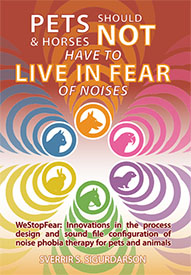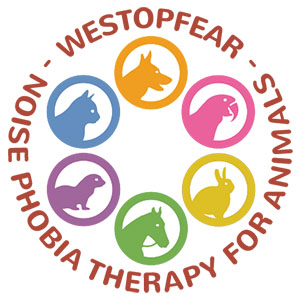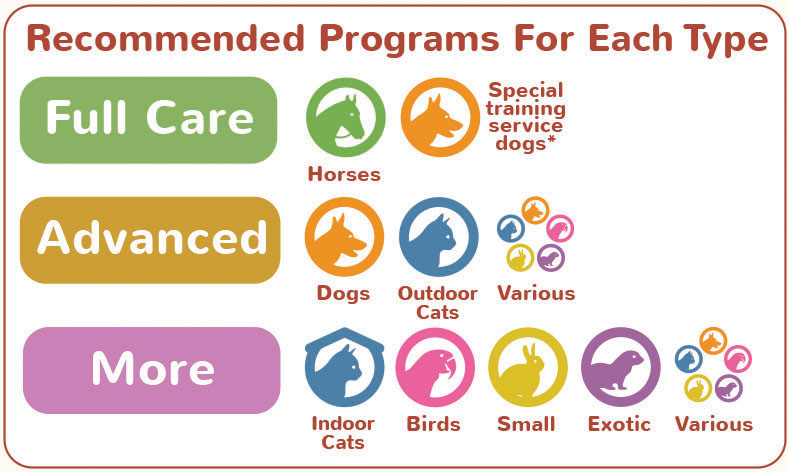 The text on this page is from the book "Pets and Horses Should Not Have To Live In Fear Of Noises" The book is available on Amazon.com as Print version or Kindle version.
The text on this page is from the book "Pets and Horses Should Not Have To Live In Fear Of Noises" The book is available on Amazon.com as Print version or Kindle version. (From page 106 of the book).
The new method with a new process design
The new process architecture was developed by the author, using methods from industrial management named process analysis, process re-design and re-engineering. The author’s basic understanding of these methods did not come through knowledge of psychology or dog training, but rather through the author’s education in business and industrial processes. This is the reason why the author’s innovation brings something completely new into this field, which all the dog trainers and animal psychologists of the world had not previously developed and introduced.
Here is a description of this new process. In part 4 of the book is an outlining of the history, how this new method was developed and all the steps of this journey, since the author started thinking about this field around the year 2009, and up to today.
Process analysis, process re-design and re-engineering
The author looked at the classical process of desensitization and habituation and plotted down each step of the process. He could pinpoint the weak spots of the process, where the thresholds existed that made these processes slightly difficult. Subsequently, he analyzed the goal, the steps of the method and tried to see where the methods could be improved upon.
Through this, the author realized, and was very excited when he found out, that by applying these industrial methods, he could alter and re-design the steps of the process, to eliminate at least many of the potentially risky drawbacks, and do things in a simpler, more convenient way, with less risk of mistakes than before.
The method of process analysis, process re-design and re-engineering delivered fruitful results!
Although the author doesn’t know for sure, then it is uncertain if anybody has really investigated these processes of desensitization and habituation before, from this point of view, anywhere in the world, using these types of methods of process analysis and process re-design, to pinpoint weak areas as well as opportunities to improve.
At least, he hasn’t found any evidence that anyone has done that, except for what here is called the music mix method, which seems to have appeared in the 1980s, although the Internet has not revealed to the author anything about who invented that method, and there is no patent registered for that method.
The ten factors of how WeStopFear is meant to be better
Here is a ten bullet points list that outlines in which way it has been attempted to offer a solution that is better than the ones that have been previously available.
WeStopFear is developed to be:
- Safer
- Easier
- Simpler
- Timed Access
- More Natural
- Better Tolerable
- For All Types
- Comprehensive Instructions
- Future Maintenance
- Affordable For All (Basic program very affordable, and the plan is also to offer a free solution on a separate website)
This is based on the process design innovations that are introduced with WeStopFear and other factors.
Here is a brief overview of what constitutes these items above.
Safer, easier and simpler with timed acess
The three innovations of Simple Secure Steps™, Volume Anchor™, and Timed Access™ are meant to make the process safer, as it is less likely that sounds will be played too loudly too early, which can lead to overexposure with fear and shock to the animal. This is because in the beginning, the handler implementing the therapy process only gets access to the first set of therapy sounds, where the volume is set so low that it is practically impossible to play the sounds too loudly. This means that there is Timed Access™ to the therapy sounds set.
The WeStopFear soludiont is meant to be simpler and easier, as the playback device is supposed to be playing with the same volume setting on that device in a particular location. It is also simple to find the right volume. That is simply done by playing the piano tune (the Prelude in C Major, by Johan Sebastian Bach) which serves as the Volume Anchor™. When the volume setting is shown in markings or numbers on the device, all that is needed is to write down the volume in that particular location, and then set that device to the same volume every time the sounds are played throughout all the steps.
The Timed Access™ and Volume Anchor™ together means that the steps of the process are the Simple Secure Steps™.
More natural and better tolerable
The Natural Intervals™ feature is designed to insert silences in between the therapy sounds, of randomized duration. This means that the pet/animal and the human handler along with the occasional other human members of the household get a break in between the therapy sounds. This moment of silence means that the therapy sounds will be better bearable, instead of how the process is in the conventional method, where the sounds come one right after the other without any silence in between. This arrangement is also more natural, as in real life these sounds certainly don’t appear directly one after the other, so these are Natural Intervals™.

For all types of pets and companion/recreational animals
Until now, the noise phobia therapy solutions that have been available have mainly been for dogs. The author has also seen one solution for cats and one for horses. WeStopFear will, on the other hand, have sections for practically all types of pets and animals: Dogs, cats, pet birds, small mammals, horses and the various types of less common pets collectively called exotic pets.
It is a fact that all types of animals are programmed to be wary and fearful of unknown sounds in their natural settings out in nature, and can thus have problems with unknown and/or uncomfortable sounds, along with sounds from thunderstorms, when they are kept by humans.
It is also a fact, which the author has seen, that pet owners love their pets very dearly, regardless of what kind of pet it is. It is not so that dog and cat owners love their dogs, but people who own rabbits, hamsters, birds, ferrets, etc., love their pets less because they are “just a rabbit”, “just a bird” or like that.
For that reason, WeStopFear is happy and proud to offer solutions for all types of pets.
Comprehensive Instructions
WeStopFear is a web-based solution, and with that comes the virtually unlimited space for instructions. Taking advantage of this, the instructions go from being short and simple, and to being very long and comprehensive. The user will be able to choose how much time will be spent learning the ins-and-outs of the method. Reading the short instructions and watching an instructional video will be sufficient to be able to implement the method, but deepening the understanding is good too. In all there are (at least) ten different sets of instructions, on the playback pages and also on dedicated pages. Not only that, each of the six pet-based sections have their own set of instructions. Even if the instructions are similar in their basic approach, then there may be nuances that are relevant for different types of pets, and not the least for horses who are in some ways in their own league when it comes to their situation and how the owner needs to deal with them.
Future Maintenance
Just like it is not enough to do physical exercise for several months, or practice playing a musical instrument, for several months and then you are all set for the rest of you life and you never need to touch it again, then the good results that the pet gets in the noise phobia therapy process must be maintained. Otherwise, the good noise tolerance will wean off and no longer be there to protect the pet in this regard. WeStopFear takes this fully into account. After the five steps, there is yet another playback page for future maintenance. There, the handler can choose to play the sound sets associated with Step 3, Step 4 or Step 5, based on how the handler assesses the situation of the pet when maintenance takes place. If the handler believes that playing Step 3 sound sets, then the handler should then continue and go to Step 4 and Step 5 like in the original process. Not only that; the email list will be active in sending out reminders and encouragement for the maintenance phase, as long as WeStopFear is operational and as long as the handler stays on the email list.
Affordable for all
The overall goal of WeStopFear is that the general situation for all pets and companion animals held by humans will improve, leading to a lower percentage of animals that suffer these types of problems, and a higher percentage of animals that are not suffering. That goal calls for trying to make it as straightforward and easy for the owners of these pets and animals to conduct this therapy, and to continue it into the maintenance stage preferably as long as the lifespan of each pet and animal. One important aspect of that is of course, how much money the pet owner needs to spend to implement the initial therapy process, and to continue into the maintenance stage.
Offering the Basic program for at a very affordable price, and creating another solution that will be free, takes completely away the need for the owner, to consider if the owner should spend a significant part of the owner’s disposable amount of money on noise phobia therapy or spend it on something else.
Even a relatively low amount of 20-30 USD may be too much for some, and that means that the pet or animal owned by that individual will not receive this kind of treatment. It is the goal of WeStopFear that no animal kept by humans should have to be excluded because of the financial situation of the owner.
So, as long as a pet or animal owner has in his or her possession an audio playback device that can deliver the sound of a reasonably realistic audio quality, then that owner can do this for the pet or animal with little or no economic restraints for the owner’s budget.
If a user then buys some of the products through an affiliate link, leading to a financial income for WeStopFear, then that of course is very good. But if the owner never does that, then that will not hamper the pet’s or animal’s situation. This is the fundamental policy of WeStopFear, and I am quite happy if I am able to offer that and sustain it.
Choose your pet type or horse solution introduction:
Dogs, outdoor cats, indoor cats, horses, pet birds, small mammals, exotic pets, various types of pets.
(Small mammals include rabbits, guinea pigs and hamsters. Exotic pets include chinchilla, degu, fancy mice, fancy rats, fennec fox, ferret, gerbils, hedgehog, sugarglider and pot-bellied pig. Various types of pets are any pet types combination excluding horses.)

Front Pages Links
Types Solutions
Programs
Overview
Walk through screencast video
Sounds and videos
Try the 5 steps therapy sounds players
Sounds in programs (most types)
Sounds in Solutions for Horses
Sounds in Solutions for Outdoor Cats
Explore the 5 step video therapy
Further Information
Various information from around the web
Comparing solutions in the market
A new standard practice for pets and horses?
Mobilize the world: 500 million households
Short comparison of WeStopFear and conventional process
What is noise phobia or fear of noises?
Book Chapters
 Chapters from the book "Pets and Horses Should Not Have To Live In Fear Of Noises", available on Amazon.com as Print version or Kindle version.
Chapters from the book "Pets and Horses Should Not Have To Live In Fear Of Noises", available on Amazon.com as Print version or Kindle version.
About animal types, fear of sounds, and noise phobia (page 23)
Ten items to be better (page 106)
About Simple Secure Steps and the four innovations (page 111)
Comparison of the conventional method and WeStopFear’s Simple Secure Steps (page 127)
Is this new method the best method available? (page 137)
About the Years of development (page 155)
Merch
Infographics designed by WeStopFear © Copyright.

